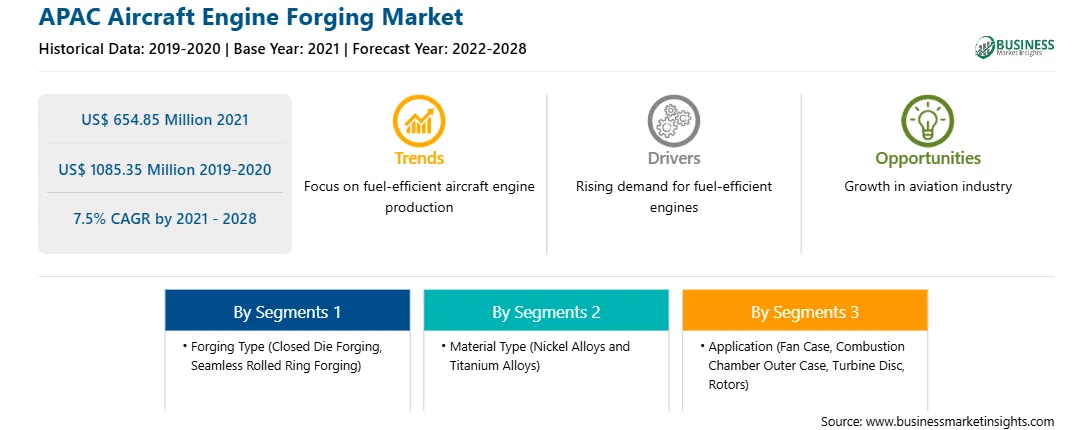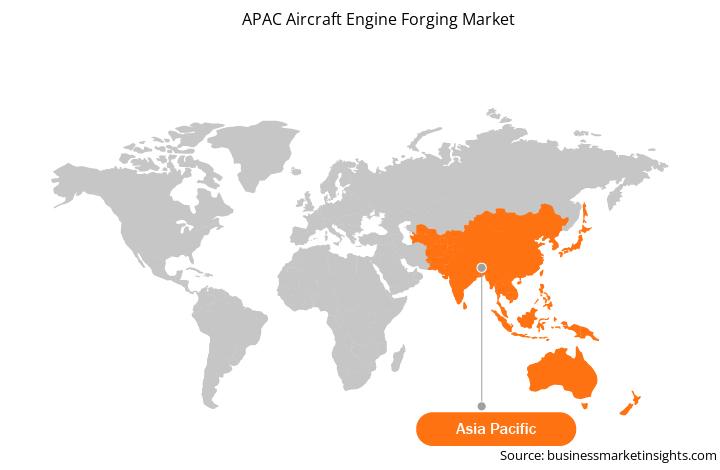The aviation industry is experiencing huge demand for air travel, for both military and commercial purposes. This is leading the aircraft manufacturers to procure the latest aircraft models, and models and adopt new and robust technologies. Therefore, the production of the next generation of aircraft is expected to be one of the key trends in the aviation industry in the future. The trend is predicted to pitch over the period, leading to huge opportunities for the proliferation of aircraft component forging players. The commercial aerospace industry is expected to prominently witness a boom in the production of a next-generation single-aisle, large twin-aisle aircraft, and jet engines. The next-generation jet engines use advanced metallic powder alloys and nickel-based superalloys. These engines is an economic model of the aircraft, which helps in enhancing fuel efficiency and aircraft performance.
The COVID-19 pandemic has not only disrupted the APAC’s economy and the region’s aerospace market but has also changed the customer attitude towards the sector. The region has witnessed a significant decline in the air transportation. Approximately 18,000 aircraft including the Boeing 747s and Airbus A380s were put in storage in 2020, due to the collapse in passenger demand and bankruptcies. From aircraft manufacturing and assembly viewpoint, China is one of the leading aerospace manufacturing countries in the region and has been one of APAC's most affected countries during Q1 and Q2 of 2020. Due to this, the manufacturing facilities have been witnessing severe conditions in aircraft and aircraft component manufacturing facilities. The Airbus and Boeing manufacturing facilities in China were shut down for a longer period, which resulted in substantial lesser demand for various components and systems including engines. Similarly, China’s indigenous aircraft manufacturer COMAC also halted its production of C919 during Q1, which resulted in negatively in aircraft engines and aircraft engine forging market. However, the aviation authorities, airlines, and aircraft manufacturers foresee a strong growth in APAC aviation industry. Owing to this, several airlines and military forces are ordering and taking deliveries of newer aircraft models. This is expected to drive the demand for aircraft engines among commercial and military aircraft manufacturers, which would boost the aircraft engine forging market player’s businesses.
With the new features and technologies, vendors can attract new customers and expand their footprints in emerging markets. This factor is likely to drive the aircraft engine forging market. The APAC aircraft engine forging market is expected to grow at a good CAGR during the forecast period.
Strategic insights for the APAC Aircraft Engine Forging provides data-driven analysis of the industry landscape, including current trends, key players, and regional nuances. These insights offer actionable recommendations, enabling readers to differentiate themselves from competitors by identifying untapped segments or developing unique value propositions. Leveraging data analytics, these insights help industry players anticipate the market shifts, whether investors, manufacturers, or other stakeholders. A future-oriented perspective is essential, helping stakeholders anticipate market shifts and position themselves for long-term success in this dynamic region. Ultimately, effective strategic insights empower readers to make informed decisions that drive profitability and achieve their business objectives within the market.

| Report Attribute | Details |
|---|---|
| Market size in 2021 | US$ 654.85 Million |
| Market Size by 2028 | US$ 1085.35 Million |
| Global CAGR (2021 - 2028) | 7.5% |
| Historical Data | 2019-2020 |
| Forecast period | 2022-2028 |
| Segments Covered |
By Forging Type
|
| Regions and Countries Covered | Asia-Pacific
|
| Market leaders and key company profiles |
The geographic scope of the APAC Aircraft Engine Forging refers to the specific areas in which a business operates and competes. Understanding local distinctions, such as diverse consumer preferences (e.g., demand for specific plug types or battery backup durations), varying economic conditions, and regulatory environments, is crucial for tailoring strategies to specific markets. Businesses can expand their reach by identifying underserved areas or adapting their offerings to meet local demands. A clear market focus allows for more effective resource allocation, targeted marketing campaigns, and better positioning against local competitors, ultimately driving growth in those targeted areas.

The APAC Aircraft Engine Forging Market is valued at US$ 654.85 Million in 2021, it is projected to reach US$ 1085.35 Million by 2028.
As per our report APAC Aircraft Engine Forging Market, the market size is valued at US$ 654.85 Million in 2021, projecting it to reach US$ 1085.35 Million by 2028. This translates to a CAGR of approximately 7.5% during the forecast period.
The APAC Aircraft Engine Forging Market report typically cover these key segments-
The historic period, base year, and forecast period can vary slightly depending on the specific market research report. However, for the APAC Aircraft Engine Forging Market report:
The APAC Aircraft Engine Forging Market is populated by several key players, each contributing to its growth and innovation. Some of the major players include:
The APAC Aircraft Engine Forging Market report is valuable for diverse stakeholders, including:
Essentially, anyone involved in or considering involvement in the APAC Aircraft Engine Forging Market value chain can benefit from the information contained in a comprehensive market report.